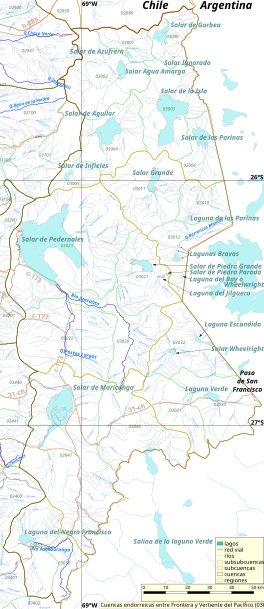Salar Ignorado
| Salar Ignorado | |
|---|---|
 At the top, the third one. | |
| Coordinates | 25°29′52″S 68°37′17″W / 25.49778°S 68.62139°W[1] |
Salar Ignorado is a salar (salt flat) in the Andes of Chile's Atacama Region at 4,250 metres (13,940 ft) elevation. Located just south of Cerro Bayo volcano, it comprises 0.7 square kilometres (0.27 sq mi) of salt flats, sand dunes and numerous pools of open water. The waters of Salar Ignorado, unlike these of other salt flats in the central Andes, are acidic owing to the input of sulfuric acid from hydrothermal water and the weathering of volcanic rocks.
The salt flat is located in a harsh climate with strong winds, large temperature fluctuations, intense
Geography and geomorphology
The salt pan is in the Chilean Andes, and, not far from the border with Argentina,[2] within the northernmost tip of the Chilean Atacama Region.[3] It is located east of Plato de Sopa volcano[4] and just south of the 5,400 metres (17,700 ft) high Cerro Bayo Complex volcano. Salar Gorbea is just northwest of Salar Ignorado[a].[1] The area is difficult to access.[6]
Salar Ignorado is triangular with a surface area of 0.7 square kilometres (0.27 sq mi) at 4,250 metres (13,940 ft) elevation,
The catchment of Salar Ignorado has a surface area of about 37.5 square kilometres (14.5 sq mi)
Hydrology and minerals
Water temperatures in the salar pools range from 9–15 °C (48–59 °F). The waters contain
The most common mineral deposited at Salar Ignorado is
2S bubbles.[24] Large gypsum crystals are cemented by smaller crystals.[25] Groundwater precipitates minerals like alunite, hematite, jarosite and kaolinite.[26]
The acidity is unusual for salars in Chile and there is no obvious reason for it in the geology of the area.
Climate and ecology
Mean temperatures are about −2 °C (28 °F) but fluctuations of 1–25 °C (34–77 °F) were documented in summer months.
There is no evidence of crustaceans at Salar Ignorado.[36] Only one mammal was observed in the area during a reconnaissance reported in 2013,[5] and a vicuña skeleton was reported in 2008.[36]
Notes
References
- ^ a b c d Karmanocky & Benison 2016, p. 492.
- ^ a b Karmanocky & Benison 2016, p. 491.
- ^ Benison 2019, p. 148.
- ^ Pueyo et al. 2021, p. 5.
- ^ a b Universidad de Antofagasta, Institut de recherche pour le développement & Haimaitier Institute 2013, p. 93.
- ^ a b Risacher, Alonso & Salazar 2002, p. 42.
- ^ Benison 2019, p. 152.
- ^ Benison 2019, p. 154.
- ^ a b c d e f g Karmanocky & Benison 2016, p. 493.
- ^ Risacher, Alonso & Salazar 2002, p. 46.
- ^ a b c Karmanocky & Benison 2016, p. 494.
- ^ a b Pueyo et al. 2021, p. 14.
- ^ a b Risacher, Alonso & Salazar 2002, p. 43.
- ^ Risacher, Alonso & Salazar Méndez 1999, p. 16.
- ^ Benison 2019, p. 164.
- ^ Escudero et al. 2018, p. 1403.
- ^ a b c Risacher, Alonso & Salazar 2003, p. 253.
- ^ Pueyo et al. 2021, p. 3.
- ^ Benison 2019, p. 149.
- ^ Benison 2019, p. 151.
- ^ a b c Karmanocky & Benison 2016, p. 490.
- ^ Risacher, Alonso & Salazar Méndez 1999, p. 19.
- ^ a b c Karmanocky & Benison 2016, p. 502.
- ^ a b Karmanocky & Benison 2014, p. 24.
- ^ Benison 2019, p. 158.
- ^ a b c Karmanocky & Benison 2014, p. 23.
- ^ Risacher, Alonso & Salazar Méndez 1999, p. 6.
- ^ Pueyo et al. 2021, p. 2.
- ^ Karmanocky & Benison 2016, p. 503.
- ^ Risacher, Alonso & Salazar 2002, p. 52.
- ^ Risacher, Alonso & Salazar 2002, p. 55.
- ^ Pueyo et al. 2021, p. 13.
- ^ Benison 2019, p. 159.
- ^ Universidad de Antofagasta, Institut de recherche pour le développement & Haimaitier Institute 2013, p. 63.
- ^ Benison 2019, p. 165.
- ^ a b Benison 2019, p. 162.
Sources
- Benison, Kathleen C. (2019-02-21). "The Physical and Chemical Sedimentology of Two High-Altitude Acid Salars in Chile: Sedimentary Processes In An Extreme Environment". Journal of Sedimentary Research. 89 (2): 147–167. S2CID 135031173 – via ResearchGate.
- Karmanocky, F.J.; Benison, K.C. (2014). Fluid inclusion petrography, microthermometry, and geobiology in modern gypsum from acid saline Salar Ignorado, northern Chile (PDF). Pan-American Current Research on Fluid Inclusions (PACROFI-XII). Vol. 23.
- Karmanocky, F. J.; Benison, K. C. (August 2016). "A fluid inclusion record of magmatic/hydrothermal pulses in acid Salar Ignorado gypsum, northern Chile". Geofluids. 16 (3): 490–506. .
- Escudero, Lorena; Oetiker, Nia; Gallardo, Karem; Tebes-Cayo, Cinthya; Guajardo, Mariela; Nuñez, Claudia; Davis-Belmar, Carol; Pueyo, J. J.; Chong Díaz, Guillermo; Demergasso, Cecilia (1 August 2018). "A thiotrophic microbial community in an acidic brine lake in Northern Chile". Antonie van Leeuwenhoek. 111 (8): 1403–1419. S2CID 13684197.
- Pueyo, JuanJosé; Demergasso, Cecilia; Escudero, Lorena; Chong, Guillermo; Cortéz-Rivera, Paulina; Sanjurjo-Sánchez, Jorge; Carmona, Virginia; Giralt, Santiago (2021-07-20). "On the origin of saline compounds in acidic salt flats (Central Andean Altiplano)". Chemical Geology. 574: 120155. S2CID 233653266.
- Risacher, François; Alonso, Hugo; Salazar Méndez, Carlos (January 1999). Geoquímica de aguas en cuencas cerradas: I, II, III regiones - Chile (PDF) (Report) (in Spanish). Dirección General de Aguas.
- Risacher, François; Alonso, Hugo; Salazar, Carlos (2002-07-01). "Hydrochemistry of two adjacent acid saline lakes in the Andes of northern Chile". Chemical Geology. 187 (1): 39–57. ISSN 0009-2541.
- Risacher, François; Alonso, Hugo; Salazar, Carlos (2003-11-01). "The origin of brines and salts in Chilean salars: a hydrochemical review". Earth-Science Reviews. 63 (3): 249–293. ISSN 0012-8252.
- Universidad de Antofagasta; Institut de recherche pour le développement; Haimaitier Institute (2013). Evaluación biogeoquímica de aguas en cuencas cerradas altoandinas de la región de Atacama. Bases científicas del recurso hídrico para la innovación y la competitividad. Informe final (Report). Archived from the original (PDF) on February 13, 2024.


